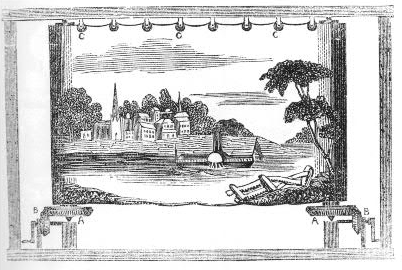Moving Panoramas
Another spectacular media-cultural form related to the grand circular panoramas, the moving panorama proved to be one of the most popular versions of the phenomenon. Very simply, it was a large and very long strip of painted fabric wound between two vertical cylinders and unrolled before an audience, accompanied by a narrator describing each scene. The moving panorama quickly established itself as an extremely popular entertainment, as a travelogue and a visually transporting way of telling a story.
The medium proved particularly popular in the United States. As the frontier expanded and explorers pushed westward, many enterprising artists traveled through the landscape creating sketches that would eventually be transformed into touring paintings. Audiences on the East Coast and across the Atlantic were treated to scenes of a wild frontier untamed by civilization, as well as overblown accounts of fortunes found and not always truthful assessments of the country's indigenous peoples.
Mechanism display for a moving panorama
The tradition of picture scrolls dates back thousands of years, to cultural traditions in Asia, India and elsewhere. In late 17th-century Europe, rolls of pictures appeared in different forms in showboxes and handheld viewers, and in the early 19th century there were even ladies' fans with miniature scrolled pictures incorporated into the designs. The moving panorama show, first popularized in England in the early 1800s, found its origins in such traditions, and expanded into two main forms: moving panoramas for the traditional theatrical realm, where moving painted scenery was used as a background in staged plays, and "peristrephic" panoramas, early independent moving panorama shows. Soon, moving panoramas also began incorporating elements of other popular media forms, including dioramas and magic lantern projections into their performances.
In the earliest days, there were those who thought moving panoramas belonged in the category that already included the peepshow and other lowly "halfpenny" entertainments found at the popular fairs. Once the concept caught on, however, subjects related to newsworthy events and exotic places captured the imagination of the public and became travel narratives of high artistic merit, presented by sophisticated travelling companies in some of the grandest halls of the day. The prominence of moving panoramas grew to such an extent over the next few decades that by the 1850s, the height of its popularity, there were hundreds of traveling shows going all over America, The U.K. and Europe. The era around 1850 marked the medium's greatest popularity and is known as the "panoramania era."
Sue Truman has a treasure trove of information on "crankies" aka moving panoramas, on her website The Crankie Factory.
Extensive information on the Moving Panorama can be found in the masterwork Illusions in Motion written by Dr. Erkki Huhtamo (MIT Press, 2013).
A toy moving panorama kit of the Grand Moving Mirror of California is available for sale in our gift shop.
